Stigmella propalaea is a species of moth in the family Nepticulidae. It is endemic to New Zealand. This species is classified as "Data Deficient" by the Department of Conservation.
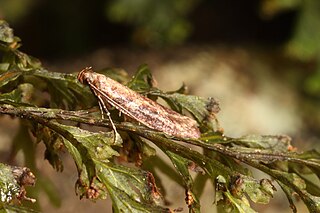
Cadmogenes is a genus of moths of the family Plutellidae. It contains only one species, Cadmogenes literata, which is found in New Zealand. This species is endemic to New Zealand. It has been classified as "Not Threatened" by the Department of Conservation.
Orocrambus punctellus is a species of moth in the family Crambidae. It is endemic to New Zealand. It is classified as "Data Deficient" by the Department of Conservation.

Pyrgotis transfixa is a species of moth of the family Tortricidae. It is endemic to New Zealand. It is classified as "At Risk, Naturally Uncommon" by the Department of Conservation.

Pyrausta comastis is a moth in the family Crambidae. This species is endemic to New Zealand. It has been classified as "nationally vulnerable" by the Department of Conservation.
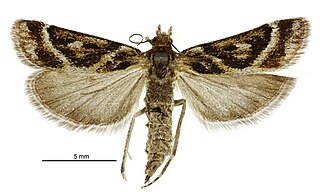
Eudonia xysmatias is a moth in the family Crambidae. It was first described by Edward Meyrick in 1907. This species is endemic to New Zealand and has been observed and collected in Otago. This species inhabits wetlands. Adults are day flying and are on the wing in December and January.

Elachista helonoma is a species of moth in the family Elachistidae. This species is endemic to New Zealand. It is classified as "At Risk, Relict'" by the Department of Conservation.
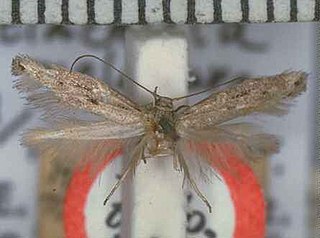
Elachista melanura is a species of moth in the family Elachistidae. This species is endemic to New Zealand. It is classified as "Data Deficient" by the Department of Conservation.

Pseudocoremia albafasciata, also known as the flash moth, is a species of moth in the family Geometridae. It is endemic to New Zealand. It is classified as Nationally Endangered by the Department of Conservation.

Pseudocoremia fluminea is a species of moth in the family Geometridae. It is endemic to New Zealand. It is classified as Not Threatened by the Department of Conservation.

Pseudocoremia lutea is a species of moth in the family Geometridae. It is endemic to New Zealand. It is classified as "At Risk, Naturally Uncommon" by the Department of Conservation.

Meterana pansicolor is a species of moth in the family Noctuidae. It is endemic to New Zealand. This species is classified as "At Risk, Naturally Uncommon" by the Department of Conservation.
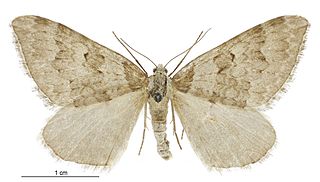
Xanthorhoe frigida is a species of moth in the family Geometridae. It is endemic to New Zealand. The larvae of this species feeds on species in the plant genus Pachycladon including the threatened Pachycladon wallii'. The adults of this species are on the wing from December to February. This moth is classified as nationally vulnerable by the Department of Conservation.
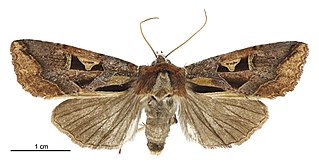
Meterana grandiosa is a species of moth in the family Noctuidae. This species is endemic to New Zealand. It is classified as "At Risk, Relict'" by the Department of Conservation.
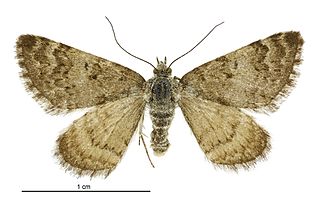
Paranotoreas fulva is a species of moth in the family Geometridae. This species is endemic to New Zealand and is found in the southern half of the South Island. The preferred habitat of this species are the salt pans of Otago, the mountainous grassland areas in South Canterbury and Otago and the glacial outwash terraces south of Tekapo. The larvae feed on Atriplex buchananii and Plantago coronopus. Adults are day flying and have been recorded as being on the wing in March, October and December. P. fulva is classified as "At Risk, Relict" by the Department of Conservation.
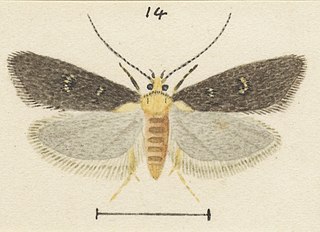
Trachypepla cyphonias is a species of moth in the family Oecophoridae. It is endemic to New Zealand and has been collected in Wellington and Taranaki. Larvae of this species have been reared from kānuka leaf litter. Adults are on the wing in December. This species is classified as "At Risk, Naturally Uncommon" by the Department of Conservation.

Tingena loxotis is a species of moth in the family Oecophoridae. This species is endemic to New Zealand and is found in the North Island. This species is found in gardens and are known to enter houses. Adults are on the wing in December and January. It is classified as "Data Deficient" by the Department of Conservation.
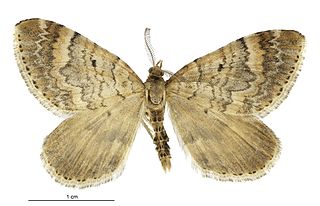
Asaphodes dionysias is a species of moth in the family Geometridae. This species is endemic to New Zealand and is only known from mountainous areas in Central Otago. It lives in open grassy mountainous habitat at altitudes up to 1750 m. It is also known to live in wetland habitat. The larvae of this species feed on native herbs. The adults of this species are on the wing in January and February. The adult female of the species has reduced wing size in comparison to the male.
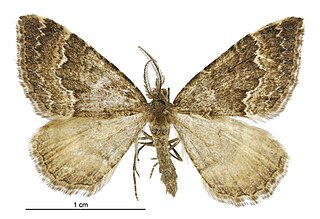
Asaphodes ida is a species of moth in the family Geometridae. It is endemic to New Zealand. This moth can be found in upland or alpine habitat in Canterbury and Otago. Although not classified under the New Zealand Threat Classification system, this species is regarded as rare.
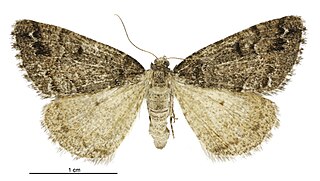
Pseudocoremia colpogramma is a species of moth in the family Geometridae. This species was described by Edward Meyrick in 1936. It is endemic to New Zealand.




















